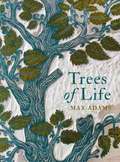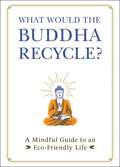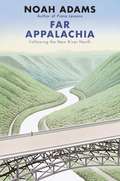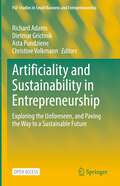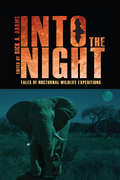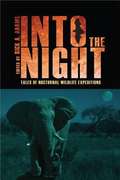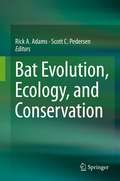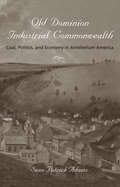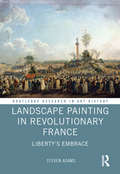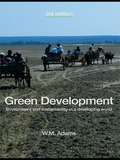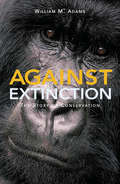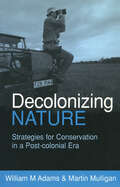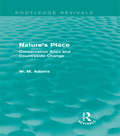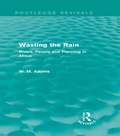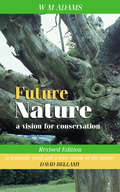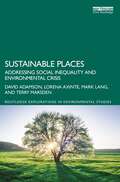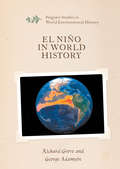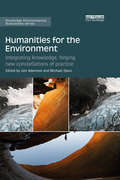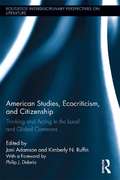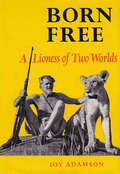- Table View
- List View
Trees of Life
by Max AdamsAn informative, richly illustrated book about eighty of the world’s most important and remarkable treesOur planet is home to some three trillion trees—roughly four hundred for every person on Earth. In Trees of Life, Max Adams selects, from sixty thousand extant species, eighty remarkable trees through which to celebrate the richness of humanity’s relationship with trees, woods, and forests.In a sequence of informative and beautifully illustrated portraits, divided between six thematic sections, Adams investigates the trees that human cultures have found most useful across the world and ages: trees that yield timber and other materials of immense practical value, trees that bear edible fruits and nuts, trees that deliver special culinary ingredients and traditions, and trees that give us dyes, essences, and medicines. In a section titled “Supertrees,” Adams considers trees that have played a pivotal role in maintaining natural and social communities, while a final section, “Trees for the Planet,” looks at a group of trees so valuable to humanity that they must be protected at all costs from loss.From the apple to the oak, the logwood to the breadfruit, and the paper mulberry to the Dahurian larch, these are trees that offer not merely shelter, timber, and fuel but also drugs, foods, and fibers. Trees of Life presents a plethora of fascinating stories about them.
What Would the Buddha Recycle?: A Mindful Guide to an Eco-Friendly Life
by Adams MediaLive the calm and eco-friendly lifestyle you&’ve always dreamed of with this perfect guide to eco-conscious living for anyone who wants to save the planet and make a difference. In today&’s world, there is a lot that can stress us out. We live in a time when talking about climate change is a hot button issue leading to political movements, youth led protests, and lots of anxiety. From green living to figuring out how you (and your family) can make a difference in your community, this mindful approach is the key to being stress-free as you make a positive impact on the environment. What Would the Buddha Recycle? can help you gain a better understanding of how you impact the world around you in your day-to-day life. And, even better, it can help you pause, reflect, and figure out what changes you can make to protect the world. In this book you&’ll learn how to: -Use natural ingredients in your home for cleaning (lemon juice can help your furniture shine) and pest control (chili pepper can deter ants) -Combine mindful cooking and eating for healthier meals that don&’t hurt the environment and make you feel great -Figure out the right food to keep your beloved pets happy and healthy by choosing natural ingredients and avoiding chemical preservatives -Include your family in your new environmentally friendly ways and raise your children to have a similar mindset about saving the planet -And much more! With advice that covers every area of your daily life, What Would the Buddha Recycle? offers easy changes so you can make a difference and protect the environment all while staying zen in the process.
Far Appalachia: following the New River north
by Noah AdamsThe host of NPR's All Things Considered and bestselling author of Piano Lessons takes us on a river journey through the heart of Appalachia-a journey shared by pioneers and preachers, white-water daredevils, bluegrass musicians, and an unforgettable cast of vivid historical characters. Following the New River North, Noah Adams has Appalachia in his blood. A native of eastern Kentucky, he comes to the headwaters of the New River not just in search of adventure but to better understand his own unique heritage. Following the New River from its mile- high source on North Carolina's Snake Mountain to its West Virginia mouth, Adams travels by canoe and by bicycle, by foot and, most thrillingly, by white-water raft to explore the history, natural beauty, and fascinating characters waiting around every bend and turn.
Artificiality and Sustainability in Entrepreneurship: Exploring the Unforeseen, and Paving the Way to a Sustainable Future (FGF Studies in Small Business and Entrepreneurship)
by Richard Adams Dietmar Grichnik Asta Pundziene Christine VolkmannThis open access edited volume explores the past, present, and future of artificiality and sustainability in entrepreneurship – the unforeseen consequences and ways to advance to a sustainable future. In particular, it connects artificiality, sustainability and entrepreneurship, intertwining artificial with the specific phenomenon of those novel digital technologies that provoke continuous and significant change in our lives and business. Unlike digital entrepreneurship research, which focuses on digital technology development and management, this book covers processes and mechanisms of sustainable adaptability of entrepreneurs, the business logic of start-ups, and the collaborative behaviours under the mass digital transformation, including the prevalence of artificial intelligence. Some of the questions that this book answers are as follows: How has entrepreneurship reacted to such challenges previously? What lessons have been learned and need to be carried forward? How can entrepreneurship and the artefacts of entrepreneurship respond to current challenges? What should be the mindset of the entrepreneur to assure sustainable adaptation? How to embrace and embed the new business logic?
Into the Night: Tales of Nocturnal Wildlife Expeditions
by Rick AdamsThis entertaining collection of essays from professional scientists and naturalists provides an enlightening look at the lives of field biologists with a passion for the hidden world of nocturnal wildlife. Into the Night explores the harrowing, fascinating, amusing, and largely unheard personal experiences of scientists willing to forsake the safety of daylight to document the natural history of these uniquely adapted animals. Contributors tell of confronting North American bears, cougars, and rattlesnakes; suffering red ctenid spider bites in the tropical rain forest; swimming through layers of feeding-frenzied hammerhead sharks in the Galapagos; evading the wrath of African bull elephants in South Africa; and delighting in the curious and gentle nature of foxes and unconditional acceptance by a family of owls. They describe “fire in the sky” across a treeless tundra, a sea ablaze with bioluminescent algae, nighttime earthquakes on the Pacific Rim, and hurricanes and erupting volcanoes on a Caribbean island. Into the Night reveals rare and unexpected insights into nocturnal field research, illuminating experiences, discoveries, and challenges faced by intrepid biologists studying nature’s nightly marvels across the globe. This volume will be of interest to scientists and general readers alike.
Into the Night
by Rick A. AdamsThis entertaining collection of essays from professional scientists and naturalists provides an enlightening look at the lives of field biologists with a passion for the hidden world of nocturnal wildlife. Into the Night explores the harrowing, fascinating, amusing, and largely unheard personal experiences of scientists willing to forsake the safety of daylight to document the natural history of these uniquely adapted animals.Contributors tell of confronting North American bears, cougars, and rattlesnakes; suffering red ctenid spider bites in the tropical rain forest; swimming through layers of feeding-frenzied hammerhead sharks in the Galapagos; evading the wrath of African bull elephants in South Africa; and delighting in the curious and gentle nature of foxes and unconditional acceptance by a family of owls. They describe "fire in the sky" across a treeless tundra, a sea ablaze with bioluminescent algae, nighttime earthquakes on the Pacific Rim, and hurricanes and erupting volcanoes on a Caribbean island. Into the Night reveals rare and unexpected insights into nocturnal field research, illuminating experiences, discoveries, and challenges faced by intrepid biologists studying nature's nightly marvels across the globe. This volume will be of interest to scientists and general readers alike.
Bat Evolution, Ecology, and Conservation
by Rick A. Adams Scott C. PedersenRecent advances in the study of bats have changed the way we understand this illusive group of mammals. This volume consist of 25 chapters and 57 authors from around the globe all writing on the most recent finding on the evolution, ecology and conservation of bats. The chapters in this book are not intended to be exhaustive literature reviews, but instead extended manuscripts that bring new and fresh perspectives. Many chapters consist of previously unpublished data and are repetitive of new insights and understanding in bat evolution, ecology and conservation. All chapters were peer-reviewed and revised by the authors. Many of the chapters are multi-authored to provide comprehensive and authoritative coverage of the topics.
Old Dominion, Industrial Commonwealth: Coal, Politics, and Economy in Antebellum America (Studies in Early American Economy and Society from the Library Company of Philadelphia)
by Sean Patrick AdamsSelected by Choice Magazine as an Outstanding Academic TitleIn 1796, famed engineer and architect Benjamin Henry Latrobe toured the coal fields outside Richmond, Virginia, declaring enthusiastically, "Such a mine of Wealth exists, I believe, nowhere else!" With its abundant and accessible deposits, growing industries, and network of rivers and ports, Virginia stood poised to serve as the center of the young nation's coal trade. By the middle of the nineteenth century, however, Virginia's leadership in the American coal industry had completely unraveled while Pennsylvania, at first slow to exploit its vast reserves of anthracite and bituminous coal, had become the country's leading producer.Sean Patrick Adams compares the political economies of coal in Virginia and Pennsylvania from the late eighteenth century through the Civil War, examining the divergent paths these two states took in developing their ample coal reserves during a critical period of American industrialization. In both cases, Adams finds, state economic policies played a major role. Virginia's failure to exploit the rich coal fields in the western part of the state can be traced to the legislature's overriding concern to protect and promote the interests of the agrarian, slaveholding elite of eastern Virginia. Pennsylvania's more factious legislature enthusiastically embraced a policy of economic growth that resulted in the construction of an extensive transportation network, a statewide geological survey, and support for private investment in its coal fields.Using coal as a barometer of economic change, Old Dominion, Industrial Commonwealth addresses longstanding questions about North-South economic divergence and the role of state government in American industrial development, providing new insights for both political and economic historians of nineteenth-century America.
Landscape Painting in Revolutionary France: Liberty's Embrace (Routledge Research in Art History)
by Steven AdamsThe French Revolution had a marked impact on the ways in which citizens saw the newly liberated spaces in which they now lived. Painting, gardening, cinematic displays of landscape, travel guides, public festivals, and tales of space flight and devilabduction each shaped citizens’ understanding of space. Through an exploration of landscape painting over some 40 years, Steven Adams examines the work of artists, critics and contemporary observers who have largely escaped art historical attention to show the importance of landscape as a means of crystallising national identity in a period of unprecedented political and social change.
Green Development: Environment and Sustainability in a Developing World
by W. M. AdamsThe concept of sustainability lies at the core of the challenge of environment and development and the way governments, business and environmental groups respond to it. Green Development provides a clear and coherent analysis of sustainable development in both theory and practice. This third edition retains the clear and powerful argument of previous editions, but has been updated to reflect advances in ideas and changes in international policy. Greater attention has been given to political ecology, environmental risk and the environmental impacts of development. This fully revised third edition discusses: the origins of thinking about sustainability and sustainable development and its evolution to the present day the ideas that dominate mainstream sustainable development (ecological modernization, market environmentalism and environmental economics) the nature and diversity of alternative ideas about sustainability that challenge 'business as usual' thinking (for example ecosocialism, ecofeminism, deep ecology and political ecology) the dilemmas of sustainability in the context of dryland degradation, deforestation, biodiversity conservation, dam construction and urban and industrial development the nature of policy choices about the environment and development strategies and between reformist and radical responses to the contemporary global dilemmas. Green Development offers clear insights into the challenges of environmental sustainability and social and economic development. It is unique in offering a synthesis of theoretical ideas on sustainability and in its coverage of the extensive literature on the environment and development around the world. This book has proved its value to generations of students as an authoritative, thought-provoking and readable guide to the field of sustainable development.
Against Extinction: The Story of Conservation
by William Bill Adams'Conservation in the 21st century needs to be different and this book is a good indicator of why.' Bulletin of British Ecological Society Against Extinction tells the history of wildlife conservation from its roots in the 19th century, through the foundation of the Society for the Preservation of the Wild Fauna of the Empire in London in 1903 to the huge and diverse international movement of the present day. It vividly portrays conservation's legacy of big game hunting, the battles for the establishment of national parks, the global importance of species conservation and debates over the sustainable use of and trade in wildlife. Bill Adams addresses the big questions and ideas that have driven conservation for the last 100 years: How can the diversity of life be maintained as human demands on the Earth expand seemingly without limit? How can preservation be reconciled with human rights and the development needs of the poor? Is conservation something that can be imposed by a knowledgeable elite, or is it something that should emerge naturally from people's free choices? These have never been easy questions, and they are as important in the 21st century as at any time in the past. The author takes us on a lively historical journey in search of the answers.
Decolonizing Nature: Strategies for Conservation in a Post-colonial Era
by William (Bill) Adams Martin MulliganBritish imperialism was almost unparalleled in its historical and geographical reach, leaving a legacy of entrenched social transformation in nations and cultures in every part of the globe. Colonial annexation and government were based on an all-encompassing system that integrated and controlled political, economic, social and ethnic relations, and required a similar annexation and control of natural resources and nature itself. Colonial ideologies were expressed not only in the progressive exploitation of nature but also in the emerging discourses of conservation. At the start of the 21st century, the conservation of nature is of undiminished importance in post-colonial societies, yet the legacy of colonial thinking endures. What should conservation look like today, and what (indeed, whose) ideas should it be based upon? Decolonizing Nature explores the influence of the colonial legacy on contemporary conservation and on ideas about the relationships between people, polities and nature in countries and cultures that were once part of the British Empire. It locates the historical development of the theory and practice of conservation - at both the periphery and the centre - firmly within the context of this legacy, and considers its significance today. It highlights the present and future challenges to conservationists of contemporary global neo-colonialism The contributors to this volume include both academics and conservation practitioners. They provide wide-ranging and insightful perspectives on the need for, and practical ways to achieve new forms of informed ethical engagement between people and nature.
Nature's Place: Conservation Sites and Countryside Change (Routledge Revivals)
by William M. AdamsNature conservation has become increasingly important in Britain over the last three decades. This title, first published in 1986, deals with the critical issues surrounding nature conservation and wildlife protection. The book is broad in scope, with a focus on the 1981 Wildlife and Countryside Act and its provisions for the protection of wildlife habitats in Sites of Special Scientific Interest (SSSIs). This follows an historical account of habitat loss over the past 200 years and the origins of conservation and site-protection policy. This reissue will be of particular value to professionals, voluntary workers and students with an interest in the origins, developments and practice of nature conservation.
Wasting the Rain: Rivers, People and Planning in Africa (Routledge Revivals)
by William M. AdamsFirst published in 1992, this title offers an experienced and constructive evaluation of the ways in which water resources have been developed in Africa. Adams argues that the best hope of productive development lies in working and engaging with local people and using local knowledge of the environment effectively. Modern, large-scale developments that have largely been ineffective are examined, and emphasis is placed on the importance of using the skills and concerns of those affected, such as small farmers, to develop ingenious water projects – an approach that can be applied worldwide. This is an interesting and relevant title, which will be of particular value to those with an interest in the developments in water resource conservation over the past two decades.
Future Nature: A Vision for Conservation
by W.M. AdamsThe countryside is changing faster than ever. Fifty years of conservation achievements in the UK are now being confronted by a new complexion of economic forces that are driving change in the countryside. At the same time new ideas in conservation are altering the role that conservation is being asked to play in negotiating the transition from past to future. This revised edition of Bill Adams classic work Future Nature tackles the new challenges in the countryside and wildlife conservation head-on through a new Introduction and Postscript with updated arguments about naturalness and our social engagement with nature, and complemented by a new Foreword by Adrian Phillips. Concepts such as biodiversity and sustainability, and changes in our understanding, appreciation and concern for nature, offer unprecedented opportunities. Bill Adams explores the scientific, cultural and economic significance of conservation. He argues that conservation must move beyond the boundaries of parks and reserves to embrace the whole countryside. The importance of conservation for the future is enormous. It holds the potential to create new spaces for nature, both in the landscape and in our lives and imaginations. This factual, beautifully written and thought-provoking book offers a fundamental reassessment of conservation, its importance, and how to achieve it. Published with BANC
Sustainable Places: Addressing Social Inequality and Environmental Crisis (Routledge Explorations in Environmental Studies)
by David Adamson Lorena Axinte Mark Lang Terry MarsdenThis book calls for more holistic place-based action to address the social and environmental crisis, deploying the Deep Place approach as one contribution to the toolbox of actions that will underpin the UN Decade of Action towards the Sustainable Development Goals. The authors suggest that ‘place’ is a critical window on how to conceive a resolution to the multiple and overlapping crises. As well as diagnosing the problem (the world as it is), this book also offers a normative advocacy (the world as it could/should be and proposed pathways to get there). A series of ‘Deep Place’ case studies from the UK, Australia, and Vanuatu help to illustrate this approach. Ultimately, the book argues for the need for a real and green ‘new deal’ and identifies what this should be like. It suggests that a new economic order, whilst eventually inevitable, requires radical change. This will not be easy but will be essential given the current impasse, caused, not least by the conjunction of carbon-based, neoliberal capitalism in crisis and the multifactorial global ecological crisis. Ultimately, it concludes that there is a need to develop a new model of ‘regenerative collectivism’ to overcome these crises. This book will be of interest to academics, policy practitioners, and social and climate justice advocates/activists.
Pets Gone Green
by Eve AdamsonIn Pets Gone Green, New York Times best-selling author Eve Adamson explores how pet owners can have a positive effect on the environment and their pets' place within it. This engaging and enlightening book outlines strategies that pet owners can pursue to reduce the family's carbon foot- and pawprints, from using less toxic flea repellant to offering earth-friendly treats and toys to our much-loved pets. Adamson's goal in writing Pets Gone Green stemmed from her desire to find ways to save her dogs from the increasingly toxic environment around us. "...we are obligated to speak up for our furry companions, who are unable to think or act green on their own." Pets Gone Green remains a timely exploration of many of the hot-button topics in our world today, from eating local and animal rescue to activism and recycling! The book offers practical advice for owners of all pets, from dogs and cats to birds, small mammals, and more.As pet rescue has increasingly become "the thing to do," the book begins with a chapter on "Recycled Companions: The Ultimate Earth-Friendly Act," in which the author discusses the many advantages of rescuing a pet from a shelter or rescue society. Pet food, another hot topic in the pet world, is the subject of "Green Food," which includes a brief history of commercial food and the pluses and minuses of using natural, homemade, raw, and vegetarian diets for pets. The chapter "Altered States" is devoted to the importance and health benefits of spaying and neutering pets. Buying and eating local, diminishing consumerism, organic materials, holistic pet care, and recycling are all discussed in terms of improving humans' and pets' lives and reducing waste on a community, national, and global level.Printed with soy ink on recycled paper, Pets Gone Green presents the original artwork of New England painter and woodblock printmaker Willy Reddick. The book includes over 50 woodblock images of her beautiful peaceful animals, lending a down-home organic feel that is truly unique for a pet book.The ultimate message of the book is summarized in the final chapter "Animal Wisdom," in which Adamson focuses in on what our pets can teach us about the world around us through their natural instincts, simplicity, and view of the world. She concludes, "...animals are companions worthy of our respect, love, and care, and because they are so close to nature in ways we can only begin to comprehend, they are also the key to our salvation....Animals understand how to live lightly on the earth, and we can learn from them." Resources of animal welfare websites and agencies, green organizations, holistic resources, green product manufacturers, and green websites and publications included. Fully indexed.
El Niño in World History (Palgrave Studies in World Environmental History)
by George Adamson Richard GroveThis book examines the role of the El Niño Southern Oscillation (ENSO) in society. Throughout human history, large or recurrent El Niños could cause significant disruption to societies and in some cases even contribute to political change. Yet it is only now that we are coming to appreciate the significance of the phenomenon. In this volume, Richard Grove and George Adamson chart the dual history of El Niño: as a global phenomenon capable of devastating weather extremes and, since the 18th century, as a developing idea in science and society. The chapters trace El Niño’s position in world history from its role in the revolution in Australian Aboriginal Culture at 5,000 BP to the 2015-16 ‘Godzilla’ event. It ends with a discussion of El Niño in the current media, which is as much a product of the public imagination as it is a natural process.
Humanities for the Environment: Integrating knowledge, forging new constellations of practice (Routledge Environmental Humanities)
by Joni Adamson Michael DavisHumanities for the Environment, or HfE, is an ambitious project that from 2013-2015 was funded by a generous grant from the Andrew W. Mellon Foundation. The project networked universities and researchers internationally through a system of 'observatories'. This book collects the work of contributors networked through the North American, Asia-Pacific, and Australia-Pacific observatories. Humanities for the Environment showcases how humanists are working to 'integrate knowledges' from diverse cultures and ontologies and pilot new 'constellations of practice' that are moving beyond traditional contemplative or reflective outcomes (the book, the essay) towards solutions to the greatest social and environmental challenges of our time. With the still controversial concept of the 'Anthropocene' as a starting point for a widening conversation, contributors range across geographies, ecosystems, climates and weather regimes; moving from icy, melting Arctic landscapes to the bleaching Australian Great Barrier Reef, and from an urban pedagogical 'laboratory' in Phoenix, Arizona to Vatican City in Rome. Chapters explore the ways in which humanists, in collaboration with communities and disciplines across academia, are responding to warming oceans, disappearing islands, collapsing fisheries, evaporating reservoirs of water, exploding bushfires, and spreading radioactive contamination. This interdisciplinary work will be of great interest to scholars in the humanities, social sciences, and sciences interested in interdisciplinary questions of environment and culture.
American Studies, Ecocriticism, and Citizenship: Thinking and Acting in the Local and Global Commons (Routledge Interdisciplinary Perspectives on Literature)
by Joni Adamson Kimberly N. Ruffin Philip J. DeloriaThis collection reclaims public intellectuals and scholars important to the foundational work in American Studies that contributed to emerging conceptions of an "ecological citizenship" advocating something other than nationalism or an "exclusionary ethics of place." Co-editors Adamson and Ruffin recover underrecognized field genealogies in American Studies (i.e. the work of early scholars whose scope was transnational and whose activism focused on race, class and gender) and ecocriticism (i.e. the work of movement leaders, activists and scholars concerned with environmental justice whose work predates the 1990s advent of the field). They stress the necessity of a confluence of intellectual traditions, or "interdisciplinarities," in meeting the challenges presented by the "anthropocene," a new era in which human beings have the power to radically endanger the planet or support new approaches to transnational, national and ecological citizenship. Contributors to the collection examine literary, historical, and cultural examples from the 19th century to the 21st. They explore notions of the common—namely, common humanity, common wealth, and common ground—and the relation of these notions to often conflicting definitions of who (or what) can have access to "citizenship" and "rights." The book engages in scholarly ecological analysis via the lens of various human groups—ethnic, racial, gendered, coalitional—that are shaping twenty-first century environmental experience and vision. Read together, the essays included in American Studies, Ecocriticism, and Citizenship create a "methodological commons" where environmental justice case studies and interviews with activists and artists living in places as diverse as the U.S., Canada, Haiti, Puerto Rico, Taiwan and the Navajo Nation, can be considered alongside literary and social science analysis that contributes significantly to current debates catalyzed by nuclear meltdowns, oil spills, hurricanes, and climate change, but also by hopes for a common future that will ensure the rights of all beings--human and nonhuman-- to exist, maintain, and regenerate life cycles and evolutionary processes
Born Free
by Joy AdamsonThere have been many accounts of the return to the wild of tame animals, but since its original publication in 1960, when The New York Times hailed it as a “fascinating and remarkable book,” Born Free has stood alone in its power to move us. Joy Adamson's story of a lion cub in transition between the captivity in which she is raised and the fearsome wild to which she is returned captures the abilities of both humans and animals to cross the seemingly unbridgeable gap between their radically different worlds. Especially now, at a time when the sanctity of the wild and its inhabitants is increasingly threatened by human development and natural disaster, Adamson's remarkable tale is an idyll, and a model, to return to again and again.
Elsa: The Story of the Famous Lioness of "Born Free"
by Joy AdamsonFrom the Book Jacket: The true story of a lioness who was brought up from cubhood by JOY ADAMSON and her husband, a senior game warden; they taught her to stalk and kill for herself so that she could be set free into the African Jungle With Picture Descriptions
Elsa And Her Cubs
by Joy AdamsonFrom the Book Jacket: In 1956, George Adamson, Senior Game Warden of the Northern Frontier District in Africa, killed a lioness, who had charged him, and brought home to his wife, Joy, three little lionesses only a few days old. Two of the cubs were sent to a zoo in Holland. The third, Elsa, remained with the Adamsons as an affectionate member of the household. In time Elsa had cubs of her own in the bush and brought them to meet the Adamsons. Because of the many photographs the Adamsons have taken of Elsa and her cubs, Mrs. Adamson has made another book so that others may share and enjoy them. She tells here the story of Elsa's cubs from the first time Elsa brought them to camp until they were taken to the Serengeti National Game Park when they were fifteen months old. With picture Descriptions.
Friends From The Forest
by Joy AdamsonFrom the Book Jacket: Foreword by Juliette Huxley In these two animal studies we have a last, touching testimony of Joy Adamson's gift for eliciting trust from creatures of the wild. The home of her later years, Elsamere, is a bungalow set on large wooded grounds bordering on the remnants of wild forest. To Joy's delight, two fascinating sets of visitors settled near Elsamere: picturesque Colobus monkeys, with their marvelously expressive faces, and a family of Verreaux's eagle owls, the third largest owl in the world and the largest in Africa, with a wingspan of twenty-three inches.
Joy Adamson's Africa
by Joy AdamsonFrom the Book Jacket: Joy Adamson is a woman of many talents and immense energy. This lavishly illustrated volume reveals the scope of her interests and achievements as wood carver, flower painter, portraitist of birds, fish, insects, animals and people. In a delightfully vivid text keyed to the illustrations, joy Adamson tells about the background of her work in the visual arts. Married to a botanist, who took her to Kenya, she started collecting and painting the indigenous flora of East Africa. Exploring the coral reefs of the Indian Ocean, she sketched the coral fish on the reef before their colors faded. She painted whatever aroused her interest : insects, reptiles, shells, and what she calls the wonders of nature-insects that shape themselves into flowers, and other forms of ingenious camouflage. On a Government commission, she made a record of the customs and costumes of the Kenya tribes, spending over six years living among these Africans, often in very isolated places. After her marriage to George Adamson, a Senior Game Warden of the Northern Frontier District, she became foster mother of lions, elephants, monkeys, a tree hyrax, a buffalo, and started her sensational work with cheetah. Living constantly near wild animals, she observed them at close range and made many sketches. This rich and varied life is here documented in pen and brush, a delight for lovers of nature and admirers of a gifted, intrepid woman, a pioneer in ecological concern.
